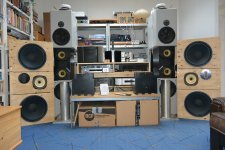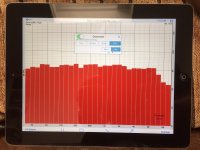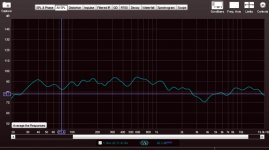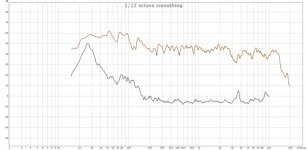Speaking from the point of view as an owner of Acoustat 2+2's, adding DSP to them would be like dumping a bunch of salt on a fine meal.
You are making the assumption that all esl speakers have wretched frequency responses that need correcting. This is not true.
ESL speakers are the most revealing speakers this side of plasma drivers. They reveal everything, including using dsp stages.
I initially had my speakers hooked up to a old pio reciever using the mcaac dsp.
Sounded great, but I discovered that even minor changes in speaker position affected the response and got a variety of different adjustments to get "flat".
Research shows that deviations of 3db or less are not audible. I experimented with positions, room treatment and when I found that there was less that 3db adjustment at the five adjustment points, I removed the pio receiver and put it in the garage. Without the dsp in the way, sounds more open.
So, I say, use a dsp to help set up, then put away.
FWIW, while the bass may lack deepness, bass from the 2+2's is very high quality, very lifelike. I'll put on Van Halen's "Everybody Wants Some" and it sounds like they are right there.
ESL speakers are very very fussy and require experimentation to zero in.
But they are worth it. You can pick up a pair for around $1,000 (mine were $500), and an amp to drive them for less (I have a hafler xl280 I picked up for $120) and have the heart of a system that will impress, sound better than anything else under $10K. I now have a NAD 208 and a Jolida JD 1000 to drive them.
If you don't want to go that route, Andrew Jones said that he uses ESL speakers as goal for his designs. I got a pair of Infinity Composition overture 3's ($300) he designed and yes, they sound pretty good, yes, in some ways they sound close to my 2+2's and yes, they sound great, but they'll never be as good sounding.
That's the cost of using cones and domes, an ESL radiating surface weighs less than the air it moves and that's partially why they sound so lifelike.
Get some acoustats and an amp that can drive them, use dsp to help set it up, then pitch it, and you'll be a happy camper.
You are making the assumption that all esl speakers have wretched frequency responses that need correcting. This is not true.
ESL speakers are the most revealing speakers this side of plasma drivers. They reveal everything, including using dsp stages.
I initially had my speakers hooked up to a old pio reciever using the mcaac dsp.
Sounded great, but I discovered that even minor changes in speaker position affected the response and got a variety of different adjustments to get "flat".
Research shows that deviations of 3db or less are not audible. I experimented with positions, room treatment and when I found that there was less that 3db adjustment at the five adjustment points, I removed the pio receiver and put it in the garage. Without the dsp in the way, sounds more open.
So, I say, use a dsp to help set up, then put away.
FWIW, while the bass may lack deepness, bass from the 2+2's is very high quality, very lifelike. I'll put on Van Halen's "Everybody Wants Some" and it sounds like they are right there.
ESL speakers are very very fussy and require experimentation to zero in.
But they are worth it. You can pick up a pair for around $1,000 (mine were $500), and an amp to drive them for less (I have a hafler xl280 I picked up for $120) and have the heart of a system that will impress, sound better than anything else under $10K. I now have a NAD 208 and a Jolida JD 1000 to drive them.
If you don't want to go that route, Andrew Jones said that he uses ESL speakers as goal for his designs. I got a pair of Infinity Composition overture 3's ($300) he designed and yes, they sound pretty good, yes, in some ways they sound close to my 2+2's and yes, they sound great, but they'll never be as good sounding.
That's the cost of using cones and domes, an ESL radiating surface weighs less than the air it moves and that's partially why they sound so lifelike.
Get some acoustats and an amp that can drive them, use dsp to help set it up, then pitch it, and you'll be a happy camper.
Last edited:
Agree with Katana.
I use OB speakers with passive XO.
In the back (picture) you see my large conventional speakers.
6x 250 watts Vincent amp for DBX driverack PA and complete d'Appolito config. 2x Eton 11 inch , 2x 7inch kevlar and Scanspeak Aircirc.
I used mini dsp before the driverack.
Just passive OB is more musical to my ears.
All those dsp stuff is a little 'artificial" , so try people to go passive all the time.
Measurement at listening position in room using iPad and cal. Dayton mic.
This was before adding the AMT tweeter
sinc. Leon
I use OB speakers with passive XO.
In the back (picture) you see my large conventional speakers.
6x 250 watts Vincent amp for DBX driverack PA and complete d'Appolito config. 2x Eton 11 inch , 2x 7inch kevlar and Scanspeak Aircirc.
I used mini dsp before the driverack.
Just passive OB is more musical to my ears.
All those dsp stuff is a little 'artificial" , so try people to go passive all the time.
Measurement at listening position in room using iPad and cal. Dayton mic.
This was before adding the AMT tweeter
sinc. Leon
Attachments
In
Likewise for open baffle DIYers, whether or not they used active crossovers?
Perhaps this seems naïve, but as I don’t play vinyl I’m looking at used DACs in the $4.5K range, so I’d rather not have lesser DAC in DSP equalizers in the speaker chain compromising my main DAC investment.
About dsp, you need no cheap minidsp, non ad da conversion....
Just take a laptop, use Jriver media player for all your digital music and maybe buy a licence for Audiolense or Acourate room correction solution, and you get state of the art dsp capabilities.
Then with a simple Ethernet cable you send the signal with a Ravenna protocol to a Merging Hapi, state of the art (8 or 16 channel) DAC.
Should be within your budget, other solution of the same cost are simply obsolete
Last edited:
Just take a laptop, use Jriver media player for all your digital music and maybe buy a licence for Audiolense or Acourate room correction solution, and you get state of the art dsp capabilities.
Then with a simple Ethernet cable you send the signal with a Ravenna protocol to a Merging Hapi, state of the art (8 or 16 channel) DAC.
OK, but isn't miniDSP or Behringer nicer about managing crossovers, time alignment, EQ for each speaker, and some other features?
B.
But above all, with my solution all dsp happens before sending the signal to the DAC, that's crucial!
crossovers, time alignment, EQ for each speaker, and some other features?
All of this and much more. You can add parametric eq, delays, shielves, low and high pass, combine as many low and high pass as you want, mix channels, Linkwitz transform, linkwitz-riley, subwoofer limiter....all these features on a channel basis and in the order that you prefer, summing as many dsp as you like until your CPU run out of power!!
Then there is also a 64 bit integrated convolution engine where you can run your FIR filters created with other software.
Then there is also a 64 bit integrated convolution engine where you can run your FIR filters created with other software.
Last edited:
I have extensive experience with JRiver and with the DCX. The DCX is easier, for sure.
But JRiver is far more flexible and powerful.
A modified DCX2496 is a handy thing to have. It can make crossover and EQ work relatively quick and easy. I say relatively, because crossover work is rarely quick, if you want good results.
For years I ran a DEQ before the DCX. That was also a handy combo.
But JRiver is far more flexible and powerful.
A modified DCX2496 is a handy thing to have. It can make crossover and EQ work relatively quick and easy. I say relatively, because crossover work is rarely quick, if you want good results.
For years I ran a DEQ before the DCX. That was also a handy combo.
Sorry about that; you’re right, I strayed off topic: Can otherwise well-designed ESLs and OBs operate very satisfactorily without benefit of any hardwired DSP in an active crossover or subwoofer (for those who might use subs)-or even software based DSP (i.e. utilities in JRiver or other players) running in the system? Or at least perform very satisfactorily without DSP in all but the worst acoustical environments (e.g. small square-like rooms).....is with double stacked Quad 57 panels. Even double stacked, they need a sub. I have built and heard a number of OB speakers that did not need a sub. But so what? That isn't the subject of this thread. You are talking about using DSP with subwoofers, this thread is about using DSP with ESL or Open Baffle. Not the same thing. Should we change to the topic of the thread to "Integrating subwoofers using DSP"?
And where little more was done beyond proper speaker placement after the room was analyzed and then received only acoustical correction.
There seems to be more than a few in the know here who have confirmed that the answer is yes-even those who have used DSP merely to design passive and/or active crossovers for their ESLs and/or OBs.
What’s that motto among many designers of some of the best sounding amplifiers?
“Make it as simple as possible-but no simpler.”
Thanks to all for contributing.
So Acoustat 3s don’t need subs.Would the size of the room make a difference on this? Or how far from the rear and side walls the 3s’ would have to be? What would power requirements need to be realize 100db SPL at 35Hz? Do most 3s’ users bi-amp them? If yes or no, then why?Acoustats do not need a sub, generally speaking, if you have model 3s or larger, and properly placed in the room. They have more bass than many dynamic speaker systems. But they are an exception in the ESL world.
What might the Quad 57s-stacked or not- have that the 3s’ don’t? And vice versa (aside from not needing subs)?
Acoustats do not need a sub, generally speaking, if you have model 3s or larger, and properly placed in the room. They have more bass than many dynamic speaker systems. But they are an exception in the ESL world.
Yes,...I have acoustat x's running, no sub, no dsp
Plenty of bass and righteous sound... to my ears.
Also, a surprising thing I learned from a pair of ML CLS...
in a smallish room, say no bigger than around 15x15ft or so, if the walls/ceiling are very stiff, say concrete or brick, the CLS didn't need a sub and sounded best I've ever heard them.
I've come to the conclusion any system lacking low end benefits greatly from stiff room construction.
The bass from a subwoofer can sound great, the bass from a pair of full range stats can sound real.
But room has a lot to do with it.You have to have them sit at least 3' away from the wall, which eats up room space ( I have mine 4'). We had the house repainted with a thick high gloss paint and that changed the sound too! They also sound different with the back wall bare, as opposed to back all with pics on it.
If you add subs to acoustats, you are trading lower response and more output for more realistic bass. Some do, some don't. These speakers get more bass with more size soa couple have taken two 2+2's and made a big speak with them.I'll be adding some infinity composition overture 3's (they have powered subs)to my Acoustats, will listen to them instead of the 2+2's when listening to rock CD's, all the vinyl stuff will still get the Acoustat 2+2's.
But room has a lot to do with it.You have to have them sit at least 3' away from the wall, which eats up room space ( I have mine 4'). We had the house repainted with a thick high gloss paint and that changed the sound too! They also sound different with the back wall bare, as opposed to back all with pics on it.
If you add subs to acoustats, you are trading lower response and more output for more realistic bass. Some do, some don't. These speakers get more bass with more size soa couple have taken two 2+2's and made a big speak with them.I'll be adding some infinity composition overture 3's (they have powered subs)to my Acoustats, will listen to them instead of the 2+2's when listening to rock CD's, all the vinyl stuff will still get the Acoustat 2+2's.
Can we see some REW freq response curves from the people who say their ESLs without a cone sub produce full bass, please.
I know that Dayton-Wright speakers (even a single pair) produce pretty nice sounding bass. They have a resonance somewhere in the vicinity of 60 Hz (and have gas and other tricks to enhance bass) but aren't outputting much below that to a mic.
It is possible that great speakers produce the partials accurately enough that the fundamental illusion is particularly good. Maybe.
I think an awful lot of people don't know how bad their judgments about bass are.
Ben
I know that Dayton-Wright speakers (even a single pair) produce pretty nice sounding bass. They have a resonance somewhere in the vicinity of 60 Hz (and have gas and other tricks to enhance bass) but aren't outputting much below that to a mic.
It is possible that great speakers produce the partials accurately enough that the fundamental illusion is particularly good. Maybe.
I think an awful lot of people don't know how bad their judgments about bass are.
Ben
Can we see some REW freq response curves from the people who say their ESLs without a cone sub produce full bass, please.
Ben
Here you go Ben,
Acoustat X... no eq, taken moments ago...
Oh, I do know what bass is....here's a thread i started on another forum...Orbit Shifters & Labhorns
Attachments
ESL can make bass. Problem is that the radiating surface has very little travel, so to get a lot of bass, you either have to make the speaker real big (like 2+2) or add a woofer (like ML and most others).
On my MCAAC, I have so that on the lowest band (40hz) I get a 3db drop off.
Keep in mind that you can't equalize past the lowest point of the response. Acoustat says these can hit down to 27hz. If you throw on an equalizer and jam up the 22hz band and play stuff in that range, you likely won't hear a difference, but the transformers will notice a lot of extra power going through them (not good) and the amp will be using a lot more power unnecessarily.
Its like that fat kid in gym class- you can poke him witha hot iron all you want but he still won't be able to run a 50 yard dash in 4 secs.
The range of ESL is fine, just takes patience to set up.
On my MCAAC, I have so that on the lowest band (40hz) I get a 3db drop off.
Keep in mind that you can't equalize past the lowest point of the response. Acoustat says these can hit down to 27hz. If you throw on an equalizer and jam up the 22hz band and play stuff in that range, you likely won't hear a difference, but the transformers will notice a lot of extra power going through them (not good) and the amp will be using a lot more power unnecessarily.
Its like that fat kid in gym class- you can poke him witha hot iron all you want but he still won't be able to run a 50 yard dash in 4 secs.
The range of ESL is fine, just takes patience to set up.
+1 for katana1100 on all points.
Many thanks to mark100 for the FR, although 1/12 might reveal a bit more fine-grain. I also do fresh REW curves and post them (when I'm not packing for a vacation) and, no disrespect, know I can pick-and-choose the ones I like best, moving the mic just inches. Being a curve poster, it is no fun when people say that to me, but it is the truth.
Yes, in my opinion, if that curve summarizes the listening experience, nobody playing acoustic music on the planar forum would be missing a thing and that includes me. It is quite good although not clear what causes the 40 Hz boost and if that boost isn't as tasty as the rest of the sound compass.
But on the sub forum, it would fall short of the ideals of posters there - maybe they play a lot of earthquake movies or the loud CD titled,"Earquake" that comes with ear plugs.
I hope I have been clear I think the curve is excellent for music and all I'd need... most days.
Ben
Many thanks to mark100 for the FR, although 1/12 might reveal a bit more fine-grain. I also do fresh REW curves and post them (when I'm not packing for a vacation) and, no disrespect, know I can pick-and-choose the ones I like best, moving the mic just inches. Being a curve poster, it is no fun when people say that to me, but it is the truth.
Yes, in my opinion, if that curve summarizes the listening experience, nobody playing acoustic music on the planar forum would be missing a thing and that includes me. It is quite good although not clear what causes the 40 Hz boost and if that boost isn't as tasty as the rest of the sound compass.
But on the sub forum, it would fall short of the ideals of posters there - maybe they play a lot of earthquake movies or the loud CD titled,"Earquake" that comes with ear plugs.
I hope I have been clear I think the curve is excellent for music and all I'd need... most days.
Ben
Ben, you need more information...... for the conclusions you are drawing.
That curve I posted was neither handpicked, nor begins to represent what the speakers sounds like. In fact, it was literally the first time I've ever measured an acoustat. I've read electrostats are inherently difficult to measure, and frankly I've given up caring about home gear quite a few years ago.
That quick curve was solely at your request to show it has good relative bass output....single octave smoothing would be fine for that purpose.
Heck, I didn't even pull the speaker out into the room position I've found that sounds best. Took 2 sweeps, first with mic on floor had no highs at all, no surprise. Next, the one posted, was simply the mic on a stand about 3ft from middle of speaker.
And no offense, but who cares what'd going on at the sub forum? A speaker's bass is defined by how low it extends, and does it have the bass volume to keep up with the rest of the spectrum at the SPL the speaker was designed for...
That curve I posted was neither handpicked, nor begins to represent what the speakers sounds like. In fact, it was literally the first time I've ever measured an acoustat. I've read electrostats are inherently difficult to measure, and frankly I've given up caring about home gear quite a few years ago.
That quick curve was solely at your request to show it has good relative bass output....single octave smoothing would be fine for that purpose.
Heck, I didn't even pull the speaker out into the room position I've found that sounds best. Took 2 sweeps, first with mic on floor had no highs at all, no surprise. Next, the one posted, was simply the mic on a stand about 3ft from middle of speaker.
And no offense, but who cares what'd going on at the sub forum? A speaker's bass is defined by how low it extends, and does it have the bass volume to keep up with the rest of the spectrum at the SPL the speaker was designed for...
On this forum, your bass is good and I think so too. On the sub forum it would be considered lacking. I don't care what people with taste might say about the paint we chose for our living room and you don't care what people in the sub forum striving for great bass might think about your bass.And no offense, but who cares what'd going on at the sub forum? A speaker's bass is defined by how low it extends, and does it have the bass volume to keep up with the rest of the spectrum at the SPL the speaker was designed for...
The last REW FR on my system was May 31 and here it is. Both L and R. With EQ. 1/12 smoothing. With THD (distortion). Mic where my head would otherwise be. BTW, both cone subs are about a half-century old.
This is a stupid argument: at their best (and uncommonly), ESLs can have good bass but not great bass. Anybody disagree with that?
Ben
Attachments
Last edited:
- Status
- This old topic is closed. If you want to reopen this topic, contact a moderator using the "Report Post" button.
- Home
- Loudspeakers
- Planars & Exotics
- How Good can OBs or ESLs Sound Without DSP?




